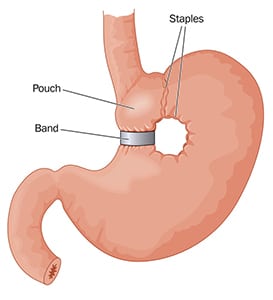Gastric Banding
 Gastric banding, more formally known as laparoscopic adjustable gastric banding, is a type of weight-loss surgery. It’s one of several restrictive surgeries in which the doctor reduces the size of the patient’s stomach. As a result, the patient gets full more quickly, so they have the potential to eat less and lose weight.
Gastric banding, more formally known as laparoscopic adjustable gastric banding, is a type of weight-loss surgery. It’s one of several restrictive surgeries in which the doctor reduces the size of the patient’s stomach. As a result, the patient gets full more quickly, so they have the potential to eat less and lose weight.
What does the procedure involve?
The surgeon performs a laparoscopy in which they make a small incision in the abdomen and insert a lighted tube with a camera called the laparoscope. It allows the surgeon to see inside the patient’s stomach.
The surgeon will make other small incisions to place other instruments in the patient’s abdomen. They will then put an adjustable band made of silicone around the upper part of the patient’s stomach. The band separates the two parts of the stomach from each other and creates a small pouch with a narrow opening that feeds into the larger lower part of the stomach.
When performed by an experienced surgeon, gastric banding does not take long. The procedure is performed under general anesthesia and does not involve any stapling or cutting inside the stomach.
What happens after the procedure?
 The patient can usually go home on the same day they have the surgery. While most patients generally take a week off from work, they can usually resume other normal activities within a day or two of going home.
The patient can usually go home on the same day they have the surgery. While most patients generally take a week off from work, they can usually resume other normal activities within a day or two of going home.
For the first two or three weeks after surgery, the patient will have to eat pureed foods or liquids. Over the next several weeks, the patient will gradually add soft foods and then normal foods to their diet. Most patients will be eating normal foods by the sixth week after surgery.
Types of Gastric Banding
Vertical banded gastroplasty is the oldest form of gastric banding, and it used to be a popular form of weight loss surgery. Although it is generally not as popular as newer and more effective techniques, it is still sometimes used if the patient isn’t a good candidate for those techniques. During the procedure, the surgeon uses staples and a band to shut off most of the stomach, leaving only a small pouch. Some surgeons use a laparoscope to guide them. The main problems with vertical banded gastroplasty are that the band used is not adjustable, and the surgery cannot be reversed.
 The REALIZE™ Band and the LAP-BAND® System are both brands of gastric bands used in the modern type of gastric banding. The REALIZE™ Band is the older brand; it was approved by the FDA in 2007, while the LAP-BAND® System was approved four years later. The surgical procedures used for implanting the bands are similar, and both bands are adjustable. They both have tubing that connect the gastric band to an access port that is implanted in the patient’s skin. The surgeon uses the access port to adjust the width of the gastric band by injecting or withdrawing a saline solution.
The REALIZE™ Band and the LAP-BAND® System are both brands of gastric bands used in the modern type of gastric banding. The REALIZE™ Band is the older brand; it was approved by the FDA in 2007, while the LAP-BAND® System was approved four years later. The surgical procedures used for implanting the bands are similar, and both bands are adjustable. They both have tubing that connect the gastric band to an access port that is implanted in the patient’s skin. The surgeon uses the access port to adjust the width of the gastric band by injecting or withdrawing a saline solution.
If the surgeon is using the REALIZE™ Band, they will not immediately fill it with saline. They will wait for the patient’s stomach to heal, which takes about four to six weeks. Most patients with REALIZE™ Bands undergo four adjustments during their first year and two adjustments in subsequent years. Patients with a LAP-BAND® System will generally need three adjustments during their first year, and then get adjustments only as needed.
How well does it work?
 Gastric banding can enable many patients to lose 40 to 50 percent of their excess weight following the procedure. It is also considered the safest and least invasive type of weight loss surgery. Gastric banding is also reversible; once the patient has reached their desired weight, the surgeon can remove the band, and the patient’s stomach will gradually return to its original size.
Gastric banding can enable many patients to lose 40 to 50 percent of their excess weight following the procedure. It is also considered the safest and least invasive type of weight loss surgery. Gastric banding is also reversible; once the patient has reached their desired weight, the surgeon can remove the band, and the patient’s stomach will gradually return to its original size.
The exact results that you will experience may vary, and should be discussed with your doctor before the procedure.
Who is a good candidate for gastric banding?
Gastric banding is performed on severely obese people who have not been able to lose weight through other means. Candidates must understand they will need to diet and exercise after the surgery in order to get the best results. If they do not, they will either not lose weight or increase the risk of suffering complications.
Doctors are most likely to recommend the surgery for patients who have a body mass index or BMI of at least 40 with no other major health issues. That generally describes women who are at least 80 pounds overweight and men who are at least 100 pounds overweight. The BMI of a person with a normal weight, by contrast, is between 18.5 and 25.
 Doctors might also recommend gastric banding for patients with a BMI of at least 35 if they have serious medical conditions that might be improved by major weight loss. Examples of such conditions include heart disease, sleep apnea, type 2 diabetes, and high blood pressure.
Doctors might also recommend gastric banding for patients with a BMI of at least 35 if they have serious medical conditions that might be improved by major weight loss. Examples of such conditions include heart disease, sleep apnea, type 2 diabetes, and high blood pressure.
Candidates for gastric banding need to have realistic expectations and understand the surgery is not a quick fix. The patient should continue to lose weight over the long term. In order to do so, they will have to follow the doctor’s instructions. The patient also needs to be psychologically stable and healthy enough for the procedure. Another important step in undergoing weight loss surgery is to carefully follow the doctor’s instructions before and after the procedure. These instructions will be tailored to you and your unique medical situation, and may involve direction on what to eat, medications to take, and how to ease into physical activity. It is very important to follow these instructions exactly in order to increase your changes of a smooth and easy surgery and recovery.
To learn more about gastric banding, along with other types of weight loss procedures, contact our office today for a consultation. Once you meet with your doctor and discuss your long term weight loss goals, you can begin to determine if weight loss surgery is a good fit for you.
Contact Info
3420 Bristol St #700, Costa Mesa, CA 92626, USA
Orange Location
1310 W Stewart Dr. Suite 310, Orange, CA 92868, USA





*DISCLAIMER
In compliance with 16 CFR 255 and Federal Trade Commission Guidelines on the use of endorsements and testimonials in the marketing and advertising of websites:
The testimonials, statements, and opinions presented on our website are only applicable to the individuals depicted, and may not be representative of the experience of others. The testimonials are voluntary provided and are not paid, nor were they provided with free products, services, or any benefits in exchange for said statements. The testimonials are not indicative of future results or success of any other individuals. South Coast Specialty Surgery Center cannot and does not guarantee the medical outcome or the results of individuals utilizing the services provided by us or the providers in our network, or from any of the websites we link, or refer to. The testimonials and endorsements found on the site for the benefit of the site or individual services or procedures are, to the best of our knowledge, the true statements and beliefs of the individuals providing them. In short, surgery involves risk, results may vary, and outcomes are not guaranteed.
Some pages of this website may feature a depiction of a model showing emphasis of the torso.
Product names may be mentioned in testimonials or elsewhere, and are trademarks or registered trademarks of their respective holders. Please refer to our Terms and Risks of Surgery pages for more information. Gastric Sleeve Surgery Centers performs Gastric Sleeve Surgery in Orange County, San Diego, Los Angeles, Riverside County and other location in Southern
California.







